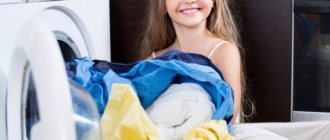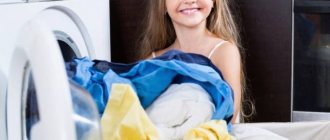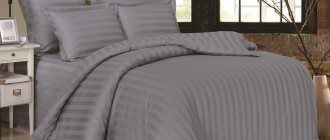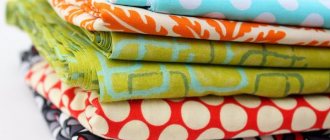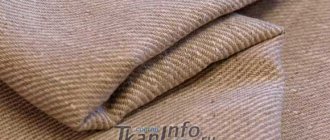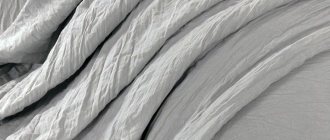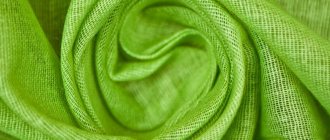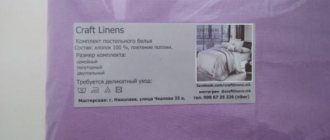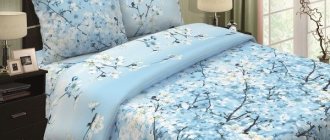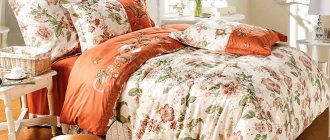Good fabric from which bed linen is made must meet many criteria, otherwise the service life of the product will be extremely minimal. Of course, natural materials are much better, their variety on the market is great. Mixed fabrics are also available. Modern synthetic materials also have a number of advantages. So which fabric is best for bedding? How to make the right choice? Start from the main features.
Calico is the most popular fabric for bed linen
Calico is completely natural (100% cotton), is easy to wash and practically does not wrinkle. Durable, wear-resistant and very inexpensive. Retains the original color brightness for a long time. Anti-allergenic, non-irritating - well suited for a baby's crib. It is recommended to wash bed linen at 40 degrees, and the fabric can be washed perfectly even with ordinary powders. Calico is simply created to be bed linen!
From reviews of bedding made from calico: “Calico is just right. Generally indestructible underwear!”;
“I love calico - it doesn’t fade, it’s pleasant to the body. I only buy these sets, I especially like the bright ones.”
Knitwear. Flannel
Knitted fabric is made from wool, cotton and synthetics. Material made of cotton and wool does not electrify, has excellent water permeability and vapor permeability. Synthetic knitwear can become electrified and will not allow air or moisture to pass through. When thinking about which fabric is best suited for bedding, focus on these characteristics. The main advantage of knitwear is its plasticity. Knitwear stretches easily, so models with elastic bands are often made from it. In any textile store you can pick up a knitted bedding. There is no need to iron it. It is in great demand during the cold season.
Flannel is also in demand during the winter cold. This is a dense material with pile, which is located on one or both sides. Flannel is made from wool, cotton using twill or plain weaving. This fabric allows air and moisture to pass through, is environmentally friendly, warm, does not prick, and does not cause irritation. After washing it only becomes softer. It is often chosen for children. Hot water causes fabric to shrink. You need to soak in cold water and wash in warm water. To remove stains, it is better to use stain removers; rubbing the fabric is not recommended to avoid the formation of pellets. When choosing a pattern, keep one thing in mind. The double-sided design does not fade. On the one hand, the lifespan of the design is short, but after fading the fabric still does not lose its positive characteristics.
Satin is the most elegant fabric for little money
Satin is made from double-woven twisted cotton thread. The greater the twist of the thread, the brighter the shine of the satin. It feels like silk, but is much cheaper (however more expensive than calico and many other cotton fabrics). Bed linen made of satin practically does not wrinkle. It withstands up to 300 washes well, but then, unfortunately, it fades. Elegant fabric and low cost.
From reviews of satin bed linen: “ Only pros, no cons. I’ve been buying only satin for about 15 years now. The fabric is thick, smooth, and it’s a pleasure to sleep. Bed linen is used for a very long time and remains of high quality.”
Which bed linen is better: cotton silk, poplin or calico
Similar news
Everyone knows that bed linen is a sheet, duvet cover and pillowcase, and they can be of very different sizes. This knowledge is undoubtedly important, but it turns out to be completely insufficient when the question arises of which bed linen is more convenient to buy.
In order to correctly select the optimal set, it is necessary to evaluate a lot of indicators: how much regular underwear costs, how long it will last, whether there will be an allergic reaction to it... In fact, the first thing the buyer encounters is the composition and type of fabric. Let's try to figure out which bed linen is better - cotton silk or poplin, or calico
?
Linen is the best natural fabric for bed linen
Linen is the most classic, time-tested fabric for bed linen. A real natural “air conditioner”: in hot weather, linen cools the skin, and in cold weather it warms. Anti-allergenic, has an antiseptic effect. Withstands an infinite number of washes. Moreover, the more washes, the lighter the linen becomes. The fabric is as close to nature as possible – and that’s probably why it has such healing properties.
From reviews of linen bed linen: “My husband and I are delighted! The material is excellent, very soft, pleasant. The design fits perfectly into the interior of a white bedroom. Linen is the best material for bed linen!”
Chintz is the cheapest but most practical fabric
Chintz is one of the cheapest fabrics for bed linen. Its qualities are similar to calico, but calico is thinner and, as a result, wears out faster. Practically does not wrinkle. Suitable for everyday use, but, unfortunately, not for long - the fabric either becomes very dull or breaks.
From reviews of chintz bed linen: “I have been buying chintz bed linen for more than 7 years. After washing, it does not settle, the design does not wear off, it is soft, and does not itch like other cheaper bedding products. And expensive bed linen, of course it can be good, but why overpay?
Calico linen
Calico
- This is a material of a higher class than
chintz
.
This is a dense plain weave fabric, in most cases entirely cotton, but sometimes there may be inserts of artificial fibers. Calico
is very durable and can withstand a considerable number of washes. It is believed that calico linen practically does not need ironing.
Sets made from calico perfectly cope with all the functions of bed linen
, they are durable, comfortable, safe and inexpensive, which makes them accessible to everyone.
Percale is the most durable bedding fabric
Percale is a kind of fabric: it feels a little like velvet. Bed linen connoisseurs compare percale to a rose petal. However, it is very dense, durable, hypoallergenic. The only drawback is it's expensive. Withstands up to 1000 washes. A real textile “fortress” - it does not leak stuffing into pillows and duvet covers.
From reviews of percale bed linen: “The fabric is durable, dense, does not fade when washed, does not shrink, and does not fade. It's comfortable to sleep on it. True, there is also a small minus - these bedding sets are a little difficult to iron even with a steamer, but this problem is solved by adding conditioner-rinse aid.”
Silk is the most luxurious fabric
Silk is truly a “royal” fabric. It has a smooth matte surface and will become a real decoration for any bed. Silk is not only beautiful bed linen, but also healing: rheumatic and skin diseases are cured faster if you sleep on silk bed linen. Hypoallergenic and stain-resistant fabric, perfectly regulates body temperature. Quite durable, does not lose color, but for such quality you have to pay a fairly large amount.
From reviews of silk bed linen: “The fabric does not wrinkle, does not fade when washed, and the pattern does not fade. I don’t know if it improves blood circulation, but I sleep comfortably, I get up in the morning rested and in a great mood. The fabric does not gather in folds, does not stick to the body, does not shock or spark.”
Poplin is the most unpretentious fabric
Poplin is a fabric that is very soft to the touch. It feels like satin, but does not have a specific matte shine. It looks very advantageous in variegated, bright colors. The most unpretentious fabric - bed linen can be washed at 60 degrees, and ironed at 110 degrees. The fabric is durable and completely non-allergenic. A good bedding fabric for those who don't want to bother with washing.
From reviews of poplin bed linen: “I like poplin bed linen, it is thin and soft to the touch, pleasant to the body and really holds the color for a long time.”
Percale (improved poplin)
Poplin fabric for bed linen, the reviews of which are most often rave, is certainly good. But many prefer percale, calling this fabric improved poplin. This material is very thin, but quite durable. The linen it makes is simply amazing. Percale has a dense structure, a velvety surface, retains heat well and allows air to pass through.
Percale fabric for bed linen is made from special cotton threads. They are not twisted, but treated with a special compound. As a result, the fibers are firmly connected, the fabric lasts a long time and is extremely durable. Percale has excellent hygienic characteristics; the fluff of the threads absorbs moisture and prevents irritation on the skin. This type of fabric is often used for sewing bedding with embroidery, as well as complex cut sets. The surface of the percale is matte, so embroideries, patterns, and various elements look great on it. The fabric can be washed at 80 degrees. The linen still looks great. Washing can also be done at lower temperatures.
Jacquard is the most delicate fabric
Jacquard is an expensive and beautiful fabric. It has a pronounced relief pattern due to the complex weaving technique. Jacquard looks luxurious and elegant. But in addition, jacquard is a very delicate fabric: washing is possible at a temperature of no more than 30 degrees. Under no circumstances should you dry it in direct sunlight. Jacquard should be ironed only from the wrong side.
From reviews of jacquard bed linen: “I like cotton jacquard the most. It's very good to sleep on it - it feels good on the body. Bed linen is easy to iron (if you iron, of course). And it looks beautiful (even if you don’t iron it). And more durable than satin."
Ranfors is the most durable fabric
Ranfors is an expensive and durable fabric. Made from 100% cotton. The weaving technique can be characterized by the phrase “thinner thread, denser weave.” In terms of “technical” characteristics, bed linen made from ranfors pleasantly surprises – it can be washed without special “greenhouse” conditions and creases minimally. The canvas does not lose its original appearance for several years. In addition, it perfectly adapts to the body - it warms you in cold weather and cools you in hot weather.
From reviews of bed linen from Ranfors: “We have had bed linen for over a year. I wash quite often at 60 degrees and 1000 spins. The set did not fade, did not stretch out or shrink, the colors remained the same. The linen is so soft, pleasant to the touch, gentle that it is pleasant to fall asleep. You feel a sense of comfort."
So what should you choose?
Chintz linen is a “country” option that involves periodic, irregular use of linen. Calico
– this is the choice of minimalists, cheap and practical.
Cotton silk is suitable for those who prefer good quality and are willing to pay for it.
And poplin is a reasonable compromise, balance, a golden mean. Every person has their own preferences in underwear, and the choice should always be correct and informed. We have described the characteristics of each type of fabric, and you can compare and choose what you like best. Published by: admin on May 25, 2021, section: Hostess, views 18382
Bamboo is the best fabric for the body
Bamboo appeared on the domestic fabric market relatively recently, but has already earned a huge army of buyers. And for good reason, because bamboo is a fabric truly created for the body. Hygroscopic, antibacterial and deodorizing - it adapts to the needs of the body and ensures healthy sleep. Bamboo bedding is a good choice for those who want a good night's rest. It is easy to care for - durable and easy to wash.
From reviews of bamboo bed linen: “I have excellent bamboo bed linen, soft and delicate, like plush. It doesn’t wash out, it doesn’t smell bad and you don’t sweat under it.”
Polycotton is the best bedding fabric for frequent washing.
Polycotton is a fabric consisting of cotton and polyester. Not only bed linen, but also table textiles are made from polycotton. Fabric with a minimum of synthetics, but it is added in order to increase the wear resistance and durability of polycotton. Does not wrinkle, practically does not get dirty, and is easy to wash - this fabric is preferred by restaurant and hotel owners for its hygiene. Washable with neutral detergent at 40 degrees.
From reviews of polycotton bed linen: “I bought polycotton bed linen and was satisfied, I’ve washed it about 8 times already, I haven’t noticed any changes, the fabric hasn’t changed color, it’s not hot to sleep, the air flows well.”
Density matters a lot
Bed linen is constantly washed. The denser the fabric, the longer such a set will last.
The density depends on the number of threads per square centimeter.
In most cases, manufacturers of competitive products indicate this indicator on their own products. According to European standards, a medium-density fabric is considered to be formed by the intersection of 50-65 threads per 1 square centimeter. The density is above average - from 60 to 80 threads.
Higher density (85-120) is already a symbol of quality. Quite high (130-280) can sometimes only make the bedding set heavier.
Well, fabrics with low density (20-30) and below average (35-40) generally lose their original appearance after several washes. The density and durability of products is determined, first of all, by the thickness of the threads. The thinner the threads, the more they can be placed on one square centimeter of fabric and vice versa.
Likewise, wear-resistant fabric for bed accessories can be created only from fine and good fibers.
Density scale
Fabric density: number of weaves (threads) per 1 square centimeter:
- 20-30 – low density;
- 35-40 – below average;
- 50-65 – average;
- 60-80 – above average;
- 85-120 – high;
- 130-280 – quite high.
According to Russian GOST, density is also determined in grams per square meter.
Polyester is the fastest drying fabric
Polyester is not only the fastest-drying fabric, but also wrinkle-resistant and does not change its size. It is produced from substances contained in oil, and the reaction must take place under conditions of high temperature and vacuum. Polyester is easy to wash (even in cold water), but requires careful ironing. In addition to bed linen, outerwear and sportswear, underwear, curtains, and draperies are made from polyester.
From reviews of polyester bedding: “Polyester is a new and fashionable fabric! Breathable. Regulates temperature and retains heat. It does not wrinkle, which is very important and very convenient for large items. No need to carefully and often iron.”
Tencel - the most technologically advanced fabric for bed linen
Tencel (tencel, tencel, lyocel) - the fabric is made using sophisticated technology from wood (most often eucalyptus). Tencel® (Tenzel) is the commercial name of the fabric produced by Lenzing (USA). Lyocell has helped the textile industry take a leap forward. The creation of this fabric is recognized as the most useful discovery in the last 30 years. It feels like cotton and looks a little like silk, but it doesn't slip. Tencel is much stronger than other natural fabrics. Does not wrinkle and retains its original color for a long time. Regulates body temperature and limits the growth of bacteria. And most importantly, its production does not harm the environment!
From reviews of Tencel bed linen: “This is not the first time I have bought Tencel bed linen. I agree that it is a little expensive, but it is so soft, dense, even slightly heavy. I don’t agree to any other – even good – bed linen!”
Fabric for bed linen: which one is better to choose?
The choice of the best fabric for bed linen should be based only on the buyer’s personal feelings. A lover of soft, warm fabric is unlikely to like the touch of cold silk, and a lover of satin will not always appreciate the relief structure of linen. It is also worth paying attention to the “performance” properties: wear resistance, long-term preservation of the original size and color, “indiscriminateness” when washing and ironing. And, of course, the final point in choosing will be the cost of the kit you like.
In any case, the most important thing is not the opinion of strangers, but the personal pleasure of sleeping on the chosen bed linen!
Selection rules
When choosing a bedding set, adhere to the following recommendations:
- Be sure to read the label. It must contain information about the manufacturer, indicate the composition of the fabric, the dimensions of the set and its design. Care instructions should also be printed. Do not buy a product with an uneven, worn, or poorly printed label. Fabric for bed linen (Ivanovo), for example, has always been of high quality.
- Look carefully at the canvas. A rare weaving structure indicates poor quality of the product. Discard this kit immediately. Such a bed will lose its appearance after a few washes. Different fabrics have different densities. Cotton and linen have 60 weaves, cambric - only 20.
- Examine the underside and seams of the laundry. There must be a linen seam. If the edges are unfinished or there is no linen seam, the product is not of the highest quality. The bed is made from whole pieces of linen; seams in the middle are not allowed.
- Pay attention to the threads. They should match the color of the fabric. No tips are allowed. The seam should be strong and not unravel.
- Smell. Only the smell of textiles is allowed. If you feel the paint, the product will fade soon. In addition, it can cause an allergic reaction.
- Everyone chooses the color scheme according to their taste. If the fabric dyeing is of high quality, bright designs and modern 3D designs look great. However, calm, monochromatic materials are also very popular.
- Sets with cartoon and fairy tale characters are suitable for children. Babies love bright colors and feel more comfortable in a rainbow atmosphere.
